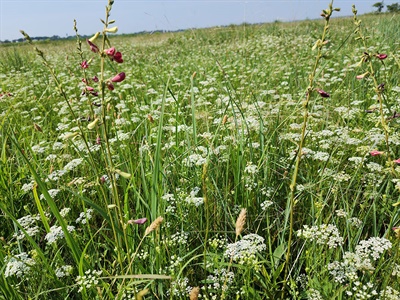By Ryan Spotts
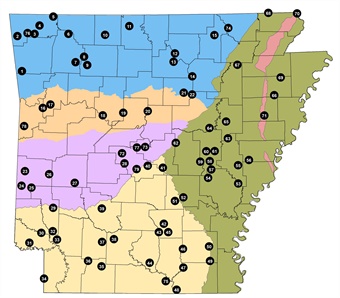 Looking back at the Arkansas Natural Heritage Commission’s (ANHC) 50 years of existence, one of the best measures of our growth is the growth of our System of Natural Areas. Over that time, ANHC staff have worked with partners and landowners to protect over 74,000 acres of land across 50 counties in Arkansas. There are now 79 natural areas that range in size from 9.6 acres to 15,900 acres. These natural areas protect the best and the rarest ecosystems, plants and animals in the state. They encompass a variety of ecosystems, including mountain forests, cave systems, savannas, glades, prairies, wetlands, rivers, streams, bayous and swamps. Many of these areas have hiking trails and most are open to hunting and fishing. These accomplishments did not happen overnight – they took five decades of hard work and persistence.
Looking back at the Arkansas Natural Heritage Commission’s (ANHC) 50 years of existence, one of the best measures of our growth is the growth of our System of Natural Areas. Over that time, ANHC staff have worked with partners and landowners to protect over 74,000 acres of land across 50 counties in Arkansas. There are now 79 natural areas that range in size from 9.6 acres to 15,900 acres. These natural areas protect the best and the rarest ecosystems, plants and animals in the state. They encompass a variety of ecosystems, including mountain forests, cave systems, savannas, glades, prairies, wetlands, rivers, streams, bayous and swamps. Many of these areas have hiking trails and most are open to hunting and fishing. These accomplishments did not happen overnight – they took five decades of hard work and persistence.
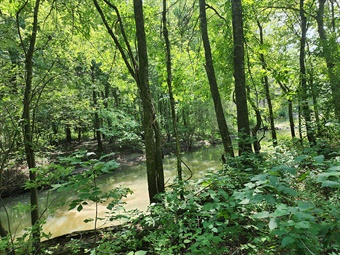 Initially, ANHC was not able to own land outright, so the first few acquisitions made by the agency were conservation easements placed on land owned by others. There are many kinds of easements, some of which are temporary and all of which specify what can or cannot be done on the land. ANHC’s conservation easements are all perpetual and are meant to ensure that the land stays in its natural state forever. Each easement is unique to its situation, but all of them forbid any kind of damage on the area they pertain to, including but not limited to development, pollution and soil disturbance. The first such easement was placed on 519 acres in Poinsett County that became ANHC’s first natural area, Singer Forest Natural Area. ANHC turned ownership of the land over to the Arkansas Game and Fish Commission (AGFC) and retained a conservation easement on it. Singer Forest Natural Area also became the first of 12 natural areas that ANHC and AGFC now co-own or co-manage.
Initially, ANHC was not able to own land outright, so the first few acquisitions made by the agency were conservation easements placed on land owned by others. There are many kinds of easements, some of which are temporary and all of which specify what can or cannot be done on the land. ANHC’s conservation easements are all perpetual and are meant to ensure that the land stays in its natural state forever. Each easement is unique to its situation, but all of them forbid any kind of damage on the area they pertain to, including but not limited to development, pollution and soil disturbance. The first such easement was placed on 519 acres in Poinsett County that became ANHC’s first natural area, Singer Forest Natural Area. ANHC turned ownership of the land over to the Arkansas Game and Fish Commission (AGFC) and retained a conservation easement on it. Singer Forest Natural Area also became the first of 12 natural areas that ANHC and AGFC now co-own or co-manage.
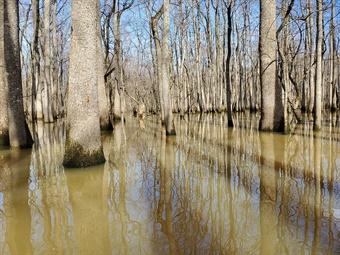 After just a few years, legislation passed that allowed ANHC to own land outright. The first land that ANHC bought and retained ownership of was 455 acres in Lonoke and Prairie counties which became Smoke Hole Natural Area. From there, the agency acquired about 3,800 acres in the 1970s and 6,900 acres in the 1980s. Funding for acquisitions picked up in the late '80s and the '90s thanks to the creation of the Arkansas Natural and Cultural Resources Council and a one-eighth cent Conservation Sales Tax. Increased funding resulted in increased acquisitions: 7,400 acres in the 1990s, 29,600 acres in the 2000s, and 21,600 acres in the 2010s. In keeping with that momentum, ANHC has already acquired 4,700 acres since January 2020.
After just a few years, legislation passed that allowed ANHC to own land outright. The first land that ANHC bought and retained ownership of was 455 acres in Lonoke and Prairie counties which became Smoke Hole Natural Area. From there, the agency acquired about 3,800 acres in the 1970s and 6,900 acres in the 1980s. Funding for acquisitions picked up in the late '80s and the '90s thanks to the creation of the Arkansas Natural and Cultural Resources Council and a one-eighth cent Conservation Sales Tax. Increased funding resulted in increased acquisitions: 7,400 acres in the 1990s, 29,600 acres in the 2000s, and 21,600 acres in the 2010s. In keeping with that momentum, ANHC has already acquired 4,700 acres since January 2020.
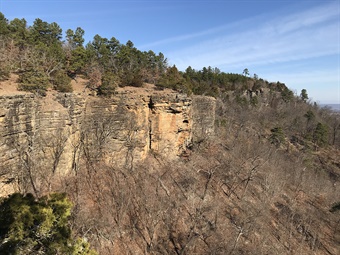 As time has passed, more and more land has been added to existing natural areas, but there are also still new natural areas being created. In 2022, two new natural areas were introduced: Sugarloaf Mountains-Midland Peak Natural Area (1,191 acres in Sebastian County) and Goat’s Beard Bluff Natural Area (540 acres in Saline County).
As time has passed, more and more land has been added to existing natural areas, but there are also still new natural areas being created. In 2022, two new natural areas were introduced: Sugarloaf Mountains-Midland Peak Natural Area (1,191 acres in Sebastian County) and Goat’s Beard Bluff Natural Area (540 acres in Saline County).
As long as unique ecosystems in Arkansas need protection, there are no plans to slow down. Here’s to another 50 years of acquiring land for protection and management within ANHC’s System of Natural Areas!
Photos:
Top — Map of locations of all 79 natural areas. Click image to see the map at a larger size.
Photo 2 — Singer Forest Natural Area.
Photo 3 — Smoke Hole Natural Area.
Photo 4 — Sugarloaf Mountains-Midland Peak Natural Area.
 Looking back at the Arkansas Natural Heritage Commission’s (ANHC) 50 years of existence, one of the best measures of our growth is the growth of our System of Natural Areas. Over that time, ANHC staff have worked with partners and landowners to protect over 74,000 acres of land across 50 counties in Arkansas. There are now 79 natural areas that range in size from 9.6 acres to 15,900 acres. These natural areas protect the best and the rarest ecosystems, plants and animals in the state. They encompass a variety of ecosystems, including mountain forests, cave systems, savannas, glades, prairies, wetlands, rivers, streams, bayous and swamps. Many of these areas have hiking trails and most are open to hunting and fishing. These accomplishments did not happen overnight – they took five decades of hard work and persistence.
Looking back at the Arkansas Natural Heritage Commission’s (ANHC) 50 years of existence, one of the best measures of our growth is the growth of our System of Natural Areas. Over that time, ANHC staff have worked with partners and landowners to protect over 74,000 acres of land across 50 counties in Arkansas. There are now 79 natural areas that range in size from 9.6 acres to 15,900 acres. These natural areas protect the best and the rarest ecosystems, plants and animals in the state. They encompass a variety of ecosystems, including mountain forests, cave systems, savannas, glades, prairies, wetlands, rivers, streams, bayous and swamps. Many of these areas have hiking trails and most are open to hunting and fishing. These accomplishments did not happen overnight – they took five decades of hard work and persistence. Initially, ANHC was not able to own land outright, so the first few acquisitions made by the agency were conservation easements placed on land owned by others. There are many kinds of easements, some of which are temporary and all of which specify what can or cannot be done on the land. ANHC’s conservation easements are all perpetual and are meant to ensure that the land stays in its natural state forever. Each easement is unique to its situation, but all of them forbid any kind of damage on the area they pertain to, including but not limited to development, pollution and soil disturbance. The first such easement was placed on 519 acres in Poinsett County that became ANHC’s first natural area, Singer Forest Natural Area. ANHC turned ownership of the land over to the Arkansas Game and Fish Commission (AGFC) and retained a conservation easement on it. Singer Forest Natural Area also became the first of 12 natural areas that ANHC and AGFC now co-own or co-manage.
Initially, ANHC was not able to own land outright, so the first few acquisitions made by the agency were conservation easements placed on land owned by others. There are many kinds of easements, some of which are temporary and all of which specify what can or cannot be done on the land. ANHC’s conservation easements are all perpetual and are meant to ensure that the land stays in its natural state forever. Each easement is unique to its situation, but all of them forbid any kind of damage on the area they pertain to, including but not limited to development, pollution and soil disturbance. The first such easement was placed on 519 acres in Poinsett County that became ANHC’s first natural area, Singer Forest Natural Area. ANHC turned ownership of the land over to the Arkansas Game and Fish Commission (AGFC) and retained a conservation easement on it. Singer Forest Natural Area also became the first of 12 natural areas that ANHC and AGFC now co-own or co-manage. After just a few years, legislation passed that allowed ANHC to own land outright. The first land that ANHC bought and retained ownership of was 455 acres in Lonoke and Prairie counties which became Smoke Hole Natural Area. From there, the agency acquired about 3,800 acres in the 1970s and 6,900 acres in the 1980s. Funding for acquisitions picked up in the late '80s and the '90s thanks to the creation of the Arkansas Natural and Cultural Resources Council and a one-eighth cent Conservation Sales Tax. Increased funding resulted in increased acquisitions: 7,400 acres in the 1990s, 29,600 acres in the 2000s, and 21,600 acres in the 2010s. In keeping with that momentum, ANHC has already acquired 4,700 acres since January 2020.
After just a few years, legislation passed that allowed ANHC to own land outright. The first land that ANHC bought and retained ownership of was 455 acres in Lonoke and Prairie counties which became Smoke Hole Natural Area. From there, the agency acquired about 3,800 acres in the 1970s and 6,900 acres in the 1980s. Funding for acquisitions picked up in the late '80s and the '90s thanks to the creation of the Arkansas Natural and Cultural Resources Council and a one-eighth cent Conservation Sales Tax. Increased funding resulted in increased acquisitions: 7,400 acres in the 1990s, 29,600 acres in the 2000s, and 21,600 acres in the 2010s. In keeping with that momentum, ANHC has already acquired 4,700 acres since January 2020. As time has passed, more and more land has been added to existing natural areas, but there are also still new natural areas being created. In 2022, two new natural areas were introduced: Sugarloaf Mountains-Midland Peak Natural Area (1,191 acres in Sebastian County) and Goat’s Beard Bluff Natural Area (540 acres in Saline County).
As time has passed, more and more land has been added to existing natural areas, but there are also still new natural areas being created. In 2022, two new natural areas were introduced: Sugarloaf Mountains-Midland Peak Natural Area (1,191 acres in Sebastian County) and Goat’s Beard Bluff Natural Area (540 acres in Saline County). As long as unique ecosystems in Arkansas need protection, there are no plans to slow down. Here’s to another 50 years of acquiring land for protection and management within ANHC’s System of Natural Areas!
Photos:
Top — Map of locations of all 79 natural areas. Click image to see the map at a larger size.
Photo 2 — Singer Forest Natural Area.
Photo 3 — Smoke Hole Natural Area.
Photo 4 — Sugarloaf Mountains-Midland Peak Natural Area.
